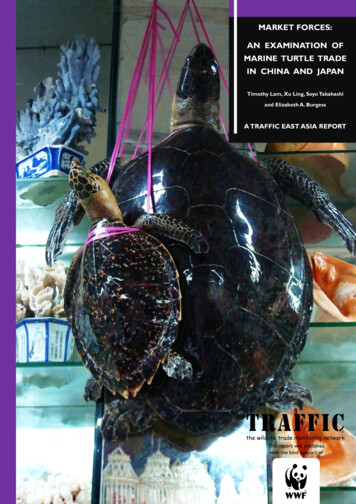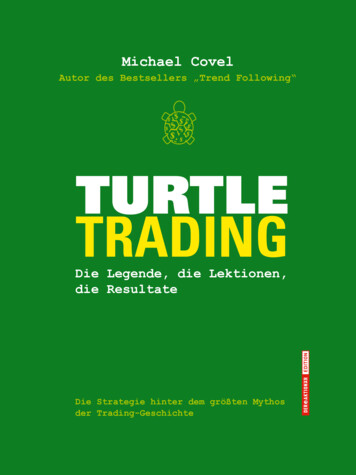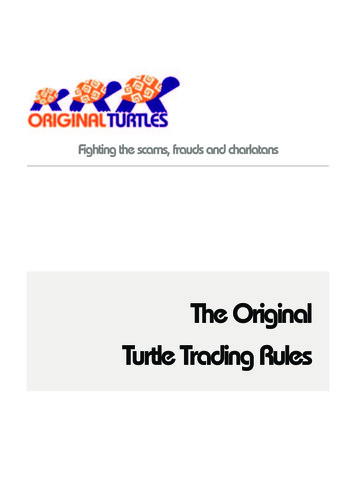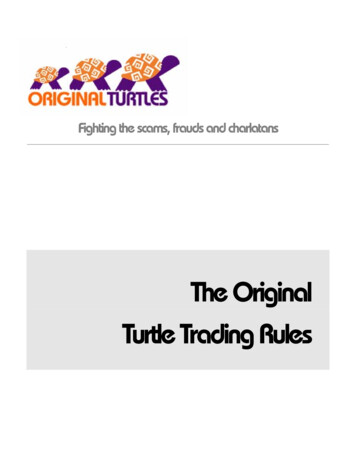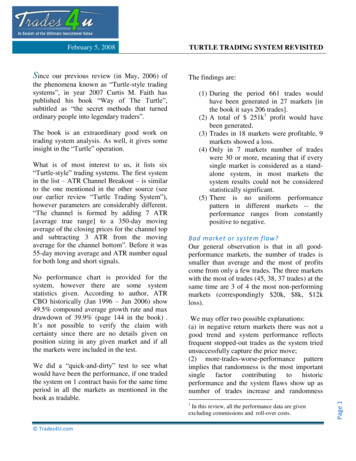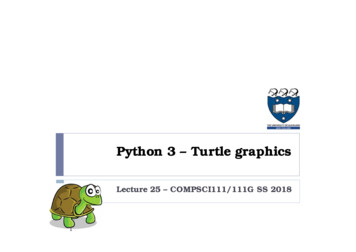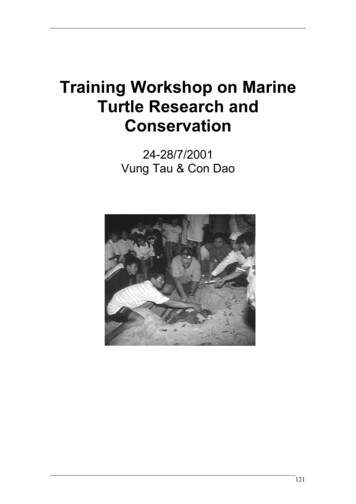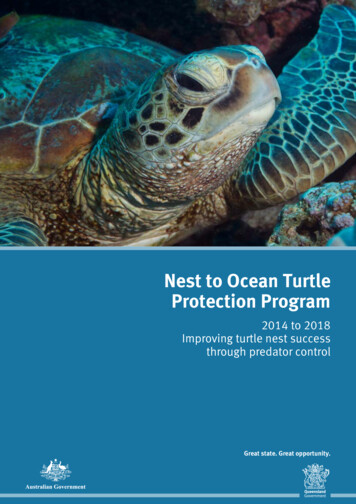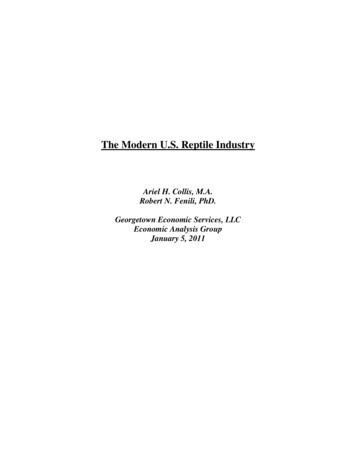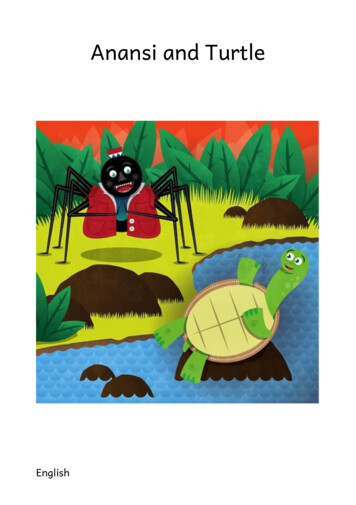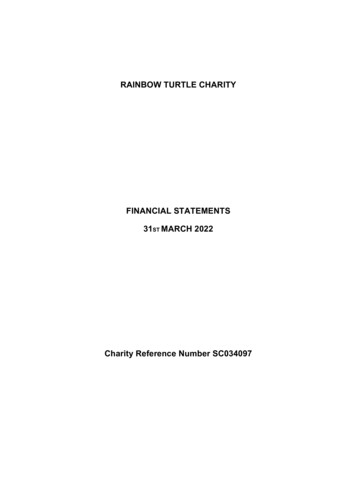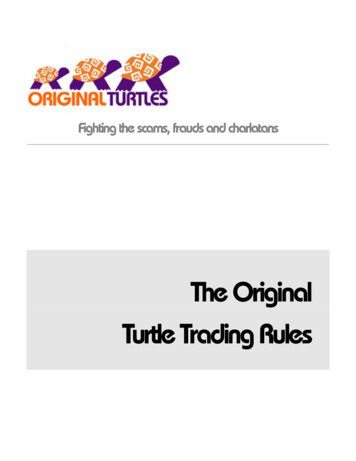
Transcription
Fighting the scams, frauds and charlatansThe OriginalTurtle Trading Rules
ORIGINALTURTLES.ORGThe Original Turtle Trading Rules 2003 OrignalTurtles.org
Table of ContentsF OR E W ORDVolatility Adjusted Position Units14Examples14Free Rules? Are you kidding?1The Importance of Position Sizing15The Origin of the Free Rules Project1Units as a measure of Risk16The Ugly Truth about the System Sellers2Adjusting Trading Size17Rules You Won’t Follow Don’t Matter3The Genesis of the Project4I NT R ODUC T I ONThe Turtle ExperimentC HAP T ER5C HAP T ERFOUREntries18Breakouts18Adding Units19Consistency20ONEA Complete Trading System7C HAP T ERThe Components of a Complete System8Stops21Markets – What to buy or sell8Turtle Stops21Position Sizing – How much to buy or sell 8Stop Placement22Entries – When to buy or sellAlternate Stop Strategy – The Whipsaw23Benefits of the Turtle System Stops248Stops – When to get out of a losing position9FI V EExits – When to get out of a winningposition9C HAP T ERTactics – How to buy or sell9Exits25Summary9Turtle Exits26These are Difficult Exits26C HAP T ERTWOMarkets: What the Turtles TradedC HAP T ERSI X10THR E EC HAP T ERSE VE NTactics27Entering Orders27Position Sizing12Fast Markets28Volatility – The Meaning of N12Simultaneous Entry Signals28Dollar Volatility Adjustment13Buy Strength – Sell Weakness29
Rolling Over Expiring Contracts29Finally30C HAP T EREI GHTFurther Study32Trading Psychology32Money Management33Trading Research33Final Warning33
ForewordORIGINAL TURTLESfFree Rules?Are you kidding?Why are some of the Original Turtles giving away Rules for whichothers have charged thousands of dollars? Are these the actualOriginal Turtle Trading System rules?You probably asked yourself the same questions: “Why would anyone giveaway the rules to the original Turtle Trading System? How can I be sure thatthese are the original Turtle Trading System rules as taught by Richard Dennisand William Eckhardt?” The answer to these questions lies in the origin ofthis project.The Origin of the Free Rules ProjectThis project had its seed in various discussions among a few of the original Turtles,Richard Dennis, and others regarding the sale of the TurtleRichard Dennis andTrading System rules by a former turtle, and subsequently, on aWilliam Eckhardtwebsite by a non-trader. It culminated in this document, whichwere not consulted prior tothe marketing of the Turtlediscloses the Original Turtle Trading Rules in their entirety, freeTrading Rules and did notof charge.benefit in any way from thesale of the Turtle Rules theydeveloped.Why? Because many of us believed that we owed an obligationto Richard Dennis not to reveal the rules, even after our contractual 10 year secrecypact ended in late 1993. For this reason, we did not look kindly upon the sale of thoserules by a former turtle.Further, we saw the sale on the web site as crass and opportunistic intellectual propertytheft, an act that, while technically not illegal, was certainly not honorable.At the same time, having seen others try to follow these rules first-hand, I realized itwas unlikely that their publication would result in very many people actually learning to1
ORIGINAL TURTLEStrade like the Turtles. In fact, I knew that most of those who spent thousands to learnthese heretofore secret rules would end up disappointed, for three reasons: The rules wouldn’t be clear, since the people selling them didn’t know how totrade. Even if they were clearly presented, the buyers probably wouldn’t be able tofollow the rules. Most of the Turtles are now trading even better rules.The Ugly Truth about the System SellersI’ve been trading and hanging around trading circles since high school. One of the sadrealities of the trading industry, and the futures trading industry in particular, is thatthere are far more people making money selling others’ systems and “ways to makemoney trading,” than there are people actually making money trading.I won’t go into specifics here, but those of us who actually trade for a living know thenames of many “famous traders” who are famous as “traders,” but that don’t makemoney as traders. They make money selling new trading systems, seminars, homestudy courses, etc. Most of these so called “experts” can’t trade and don’t trade thesystems that they sell.Yes, this is also true of those selling the Turtle Trading Rules. Consider the majorsellers: the first, a web site, TurtleTrader.com, and the second, a former turtle. Here’swhat they won’t tell you:TurtleTrader.com - A web site run mainly by one guy (an admittedly talented webmarketer that also has a pharmacy site and a site that sells personality tests),turtletrader.com purports to have the actual Turtle Trading Rules, and will sell them toyou for 999.00. The site is filled with huge amounts of information about trading, andbills itself as the “No. 1 Source for Trend Following Worldwide.”What they don’t tell you is that the site is run by a guy who doesn’t even trade his ownrules—or trade at all for that matter—and has never been a successful trader. Yet hepurports to be an expert on the “Turtle Trading Rules,” and on trend following!You can get something close to the actual rules from this site, but you won’t get anyexpert advice from the guy who runs it. All you will get is the regurgitation of advicefrom other traders that is not tempered by the experience of a successful trading career.Paying for advice from this source is a lot like hiring a blind guide.In the final analysis, TurtleTrader.com is not any better than other scams and systemselling hucksters he warns about. It is a site run by a guy who appears to me to be more2
ORIGINAL TURTLESinterested in taking his customers’ money than he is in their success with the system hesells; a site run by someone who misrepresents himself as an expert in trend following,yet doesn’t mention that he doesn’t trade.The money-back guarantee is almost worthless; you have to keep a log of all yourtrades and prove that you made them in the markets by providing your brokeragestatements. If you don’t like the rules and want your money back, it seems exceedinglyunlikely that you would open a trading account and then trade for a year just to get therefund.Former Turtle - This individual, a former turtle, sells tapes, books, hotlines, videos,seminars, and more, for prices ranging from 29.95 to 2,500.What the Former Turtle won’t tell you is that he never made money as a turtle; in facthe didn’t last a full year as a turtle before he was fired from the turtle program becausehe couldn’t trade the Turtle System Rules successfully. He lost money while most ofthe other traders were making a lot of money.The Former Turtle lends credence to the oft quoted maxim: “Those that can do, thosethat can’t teach.”I haven’t seen the seminar or read the books, but I can’t imagine how someone whocouldn’t make money after having been taught directly by Richard Dennis can explainto others how to trade using the Turtle Trading Rules.Rules You Won’t Follow Don’t MatterWhat TurtleTrader.com and the Former Turtle don't tell you is that trading rules areonly a small part of successful trading. The most importantFollowing Rulesaspects of successful trading are confidence, consistency, andAs famous trader and fatherof the Turtles, Richarddiscipline.Dennis said: “I always saythat you could publish mytrading rules in thenewspaper and no onewould follow them. The keyis consistency and discipline.Almost anybody can makeup a list of rules that are80% as good as what wetaught our people. Whatthey couldn’t do is give themthe confidence to stick tothose rules even when thingsare going bad.” – fromMarket Wizards, by Jack D.Schwager.Rules that you can’t or won’t follow will not do you any good.The Turtles had a lot of reasons to be confident in the rules theywere given. For the most part, we had the confidence to followthem even during losing periods. Those who didn’t consistentlyfollow the rules didn’t make money and were dropped from theprogram.Traders who want to be successful will figure out a way to gainenough confidence in their own rules of trading to be able toapply them consistently.3
As original Turtles, we had it easy. We were given rules by some of the world’s mostsuccessful and famous traders, Richard Dennis and his trading partner Bill Eckhardt.They taught us the rules and the reasons why we could trust those rules. Then we wereplaced into an open office with ten other traders who had been taught those samerules. In some respects it was easier to follow the rules than to not follow the rules.On the whole, we had the confidence and the discipline to consistently apply the ruleswe were given. This was the secret of our success as traders.Those who failed to follow the rules invariably failed as Turtles. Some of them decidedthey could make more money selling the Turtle rules than they did as Turtles.The Genesis of the ProjectLike many of the other Turtles, it always bothered me that some were making moneyoff the work of Richard Dennis and Bill Eckhardt without their consent; that thesesecret-sellers had used the success of the Turtles to dupe others into spendingthousands of dollars on products that were not what they appeared.I had often thought that a great way to deal with this problem would be to give theTurtle Trading Rules away for free. Since others had already let the cat out of the bag,and since anyone who really wanted the rules could already get them by paying, itwouldn’t violate my sense of fair play to reveal them.So that is what we have done.with a slight twist.While the rules are free, we respectfully ask that those who gain benefit from the rulesand find them valuable send a donation supporting a charity in honor of RichardDennis, Bill Eckhardt and the original Turtles. You can find a copy of the charitiesfavored by the Turtles on the new web site: originalturtles.org.Curtis Faith, an Original Turtle4
IntroductionORIGINAL TURTLESiThe Turtle ExperimentRichard Dennis wanted to find out whether great traders are bornor made.The age old question: Nature or nurture?In mid-1983, famous commodities speculator Richard Dennis was having anongoing dispute with his long-time friend Bill Eckhardt about whether greattraders were born or made. Richard believed that he could teach people to becomegreat traders. Bill thought that genetics and aptitude were the determining factors.In order to settle the matter, Richard suggested that they recruit and train some traders,and give them actual accounts to trade to see which one of them was correct.They took out a large ad advertising positions for trading apprentices in Barron’s, theWall Street Journal and the New York Times. The ad stated thatTrading wasafter a brief training session, the trainees would be supplied withTeachablean account to trade."Trading was even moreteachable than I imagined,"he says. "In a strange sort ofway, it was almosthumbling." – RichardDennis, Wall Street Journal.Since Rich was probably the most famous trader in the world atthe time, he received submissions from over 1000 applicants. Ofthese, he interviewed 80.This group was culled to 10, which became 13 after Rich added three people he alreadyknew to the list. We were invited to Chicago and trained for two weeks at the end ofDecember, 1983, and began trading small accounts at the beginning of January. Afterwe proved ourselves, Dennis funded most of us with 500,000 to 2,000,000 accountsat the start of February.“The students were called the ‘Turtles.’ (Mr. Dennis, who says he had just returnedfrom Asia when he started the program, explains that he described it to someone bysaying, ‘We are going to grow traders just like they grow turtles in Singapore.’)” –Stanley W. Angrist, Wall Street Journal 09/05/19895
ORIGINAL TURTLESThe Turtles became the most famous experiment in trading history because over thenext four years, we earned an average annual compound rate of return of 80%.Yes, Rich proved that trading could be taught. He proved that with a simple set ofrules, he could take people with little or no trading experience and make them excellenttraders.Continue reading. The complete set of the rules that Richard Dennis taught his traineesfollows, starting with the next chapter.6
ChapterORIGINAL TURTLES1A CompleteTrading SystemThe Turtle Trading System was a Complete Trading System, onethat covered every aspect of trading, and left virtually no decision tothe subjective whims of the trader.Most successful traders use a mechanical trading system. This is nocoincidence.A good mechanical trading system automates the entire process of trading.The system provides answers for each of the decisions a trader must make whiletrading. The system makes it easier for a trader to trade consistently because there is aset of rules which specifically define exactly what should be done. The mechanics oftrading are not left up to the judgment of the trader.If you know that your system makes money over the long run, it is easier to take thesignals and trade according to the system during periods of losses. If you are relying onyour own judgment during trading, you may find that you are fearful just when youshould be bold, and courageous when you should be cautious.If you have a mechanical trading system that works, and you follow it consistently,your trading will be consistent despite the inner emotional struggles that might comefrom a long series of losses, or a large profit. The confidence, consistency, anddiscipline afforded by a thoroughly tested mechanical system are the key to many ofthe most profitable traders’ success.The Turtle Trading System was a Complete Trading System. Its rules covered everyaspect of trading, and left no decisions to the subjective whims of the trader. It hadevery component of a Complete Trading System.7
ORIGINAL TURTLESThe Components of a Complete SystemA Complete Trading System covers each of the decisions required for successfultrading: Markets - What to buy or sell Position Sizing - How much to buy or sell Entries - When to buy or sell Stops - When to get out of a losing position Exits - When to get out of a winning position Tactics - How to buy or sellMarkets – What to buy or sellThe first decision is what to buy and sell, or essentially, what markets to trade. If youtrade too few markets you greatly reduce your chances of getting aboard a trend. At thesame time, you don’t want to trade markets that have too low a trading volume, or thatdon’t trend well.Position Sizing – How much to buy or sellThe decision about how much to buy or sell is absolutely fundamental, and yet is oftenglossed over or handled improperly by most traders.How much to buy or sell affects both diversification and money management.Diversification is an attempt to spread risk across many instruments, and to increasethe opportunity for profit by increasing the opportunities for catching successfultrades. Proper diversification requires making similar, if not identical bets on manydifferent instruments. Money management is really about controlling risk by notbetting so much that you run out of money before the good trends come.How much to buy or sell is the single most important aspect of trading. Mostbeginning traders risk far too much on each trade, and greatly increase their chances ofgoing bust, even if they have an otherwise valid trading style.Entries – When to buy or sellThe decision of when to buy or sell is often called the entry decision. Automatedsystems generate entry signals which define the exact price and market conditions toenter the market, whether by buying or selling.8
ORIGINAL TURTLESStops – When to get out of a losing positionTraders who do not cut their losses will not be successful in the long term. The mostimportant thing about cutting your losses is to predefine the point where you will getout before you enter a position.Exits – When to get out of a winning positionMany “trading systems” that are sold as complete trading systems do not specificallyaddress the exit of winning positions. Yet the question of when to get out of a winningposition is crucial to the profitability of the system. Any trading system that does notaddress the exit of winning positions is not a Complete Trading System.Tactics – How to buy or sellOnce a signal has been generated, tactical considerations regarding the mechanics ofexecution become important. This is especially true for larger accounts, where the entryand exit of positions can result in significant adverse price movement, or marketimpact.SummaryUsing a mechanical system is the best way to consistently make money trading. If youknow that your system makes money over the long run, it is easier to take the signalsand follow the system during periods of losses. If you rely on your own judgment,during trading you may find that you are fearful just when you should be courageous,or courageous when you should be fearful.If you have a profitable mechanical trading system, and you follow it religiously, thenyour trading will be profitable, and the system will help you survive the emotionalstruggles that inevitably result from a long series of losses, or large profits.The trading system that was used by the Turtles was a Complete Trading System. Thiswas a major factor in our success. Our system made it easier to trade consistently, andsuccessfully, because it did not leave important decisions to the discretion of the trader.9
ChapterORIGINAL TURTLES2Markets:What the Turtles TradedThe Turtles traded liquid futures that traded on U.S. exchanges inChicago and New York.The Turtles were futures traders, at the time more popularly called commoditiestraders. We traded futures contracts on the most popular U.S. commoditiesexchanges.Since we were trading millions of dollars, we could not trade markets that only traded afew hundred contracts per day because that would mean thatLiquiditythe orders we generated would move the market so much that itThe primary criterion usedto determine the futures that would be too difficult to enter and exit positions without takingcould be traded by thelarge losses. The Turtles traded only the most liquid markets.Turtles was the liquidity ofthe underlying markets.In general, the Turtles traded all liquid U.S. markets except the grains and the meats.Since Richard Dennis was already trading the full position limits for his own account,he could not permit us to trade grains for him without exceeding the exchange’sposition limits.We did not trade the meats because of a corruption problem with the floor traders inthe meat pits. Some years after the Turtles disbanded, the FBI conducted a major stingoperation in the Chicago meat pits and indicted many traders for price manipulationand other forms of corruption.The following is a list of the futures markets traded by the Turtles:Chicago Board of Trade 30 Year U.S. Treasury Bond10 Year U.S. Treasury Note10
ORIGINAL TURTLESNew York Coffee Cocoa and Sugar Exchange CoffeeCocoaSugarCottonChicago Mercantile Exchange Swiss FrancDeutschmarkBritish PoundFrench FrancJapanese YenCanadian DollarS&P 500 Stock IndexEurodollar90 Day U.S. Treasury Bill GoldSilverCopper ComexNew York Mercantile Exchange Crude OilHeating OilUnleaded GasThe Turtles were given the discretion of not trading any of the commodities on the list.However, if a trader chose not to trade a particular market, then he was not to tradethat market at all. We were not supposed to trade markets inconsistently.11
ChapterORIGINAL TURTLES3Position SizingThe Turtles used a volatility-based constant percentage risk positionsizing algorithm.Position sizing is one of the most important but least understood componentsof any trading system.The Turtles used a position sizing algorithm that was very advanced for its day,because it normalized the dollar volatility of a position by adjusting the position sizebased on the dollar volatility of the market. This meant that a given position wouldtend to move up or down in a given day about the same amount in dollar terms (whencompared to positions in other markets), irrespective of the underlying volatility of theparticular market.This is true because positions in markets that moved up and down a large amount percontract would have an offsetting smaller number of contracts than positions inmarkets that had lower volatility.This volatility normalization is very important because it means that different trades indifferent markets tend to have the same chance for a particular dollar loss or aparticular dollar gain. This increased the effectiveness of the diversification of tradingacross many markets.Even if the volatility of a given market was lower, any significant trend would result ina sizeable win because the Turtles would have held more contracts of that lowervolatility commodity.Volatility – The Meaning of NThe Turtles used a concept that Richard Dennis and Bill Eckhardt called N torepresent the underlying volatility of a particular market.12
ORIGINAL TURTLESN is simply the 20-day exponential moving average of the True Range, which is nowmore commonly known as the ATR. Conceptually, N represents the average range inprice movement that a particular market makes in a single day, accounting for openinggaps. N was measured in the same points as the underlying contract.To compute the daily true range:True Range Maximum(H - L, H - PDC, PDC - L)where:H – Current HighL – Current LowPDC – Previous Day’s CloseTo compute N use the following formula:N ( 19 PDN TR )20where:PDN – Previous Day’s NTR – Current Day’s True RangeSince this formula requires a previous day’s N value, you must start with a 20-daysimple average of the True Range for the initial calculation.Dollar Volatility AdjustmentThe first step in determining the position size was to determine the dollar volatilityrepresented by the underlying market’s price volatility (defined by its N).This sounds more complicated than it is. It is determined using the simple formula:Dollar Volatility N Dollars per Point13
ORIGINAL TURTLESVolatility Adjusted Position UnitsThe Turtles built positions in pieces which we called Units. Units were sized so that 1N represented 1% of the account equity.Thus, a unit for a given market or commodity can be calculated using the followingformula:Unit 1% of AccountMarket Dollar VolatilityorUnit 1% of AccountN Dollars per PointExamplesHeating Oil HO03H:Consider the following prices, True Range, and N values for March 2003 Heating 1000.71200.70980.71100.7200Close True 310.01380.01370.01390.01360.01360.01380.01350.0133
ORIGINAL 0.02800.01340.01340.0141The unit size for the 6th of December, 2002 (using the N value of 0.0141 from the 4thof December), is as follows:Heating OilN 0.0141Account Size 1,000,000Dollars per Point 42,000 (42,000 gallon contracts with price quoted in dollars)Unit Size 0.01 1,000,000 16.880.0141 42,000Since it isn’t possible to trade partial contracts, this would be truncated to an even 16contracts.You might ask: “How often is it necessary to compute the values for N and the UnitSize?” The Turtles were provided with a Unit size sheet on Monday of each week thatlisted the N, and the Unit size in contracts for each of the futures that we traded.The Importance of Position SizingDiversification is an attempt to spread risk across many instruments and to increase theopportunity for profit by increasing the opportunities for catching successful trades. Toproperly diversify requires making similar if not identical bets on many differentinstruments.The Turtle System used market volatility to measure the risk involved in each market.We then used this risk measurement to build positions in increments that represented aconstant amount of risk (or volatility). This enhanced the benefits of diversification,and increased the likelihood that winning trades would offset losing trades.Note that this diversification is much harder to achieve when using insufficient tradingcapital. Consider the above example if a 100,000 account had been used. The unit sizewould have been a single contract, since 1.688 truncates to 1. For smaller accounts, thegranularity of adjustment is too large, and this greatly reduces the effectiveness ofdiversification.15
ORIGINAL TURTLESUnits as a measure of RiskSince the Turtles used the Unit as the base measure for position size, and since thoseunits were volatility risk adjusted, the Unit was a measure of both the risk of a position,and of the entire portfolio of positions.The Turtles were given risk management rules that limited the number of Units thatwe could maintain at any given time, on four different levels. In essence, these rulescontrolled the total risk that a trader could carry, and these limits minimized lossesduring prolonged losing periods, as well as during extraordinary price movements.An example of an extraordinary price movement was the day after the October, 1987stock market crash. The U.S. Federal Reserve lowered interest rates by severalpercentage points overnight to boost the confidence of the stock market and thecountry. The Turtles were loaded long in interest rate futures: Eurodollars, TBills andBonds. The losses the following day were enormous. In some cases, 20% to 40% ofaccount equity was lost in a single day. But these losses would have beencorrespondingly higher without the maximum position limits.The limits were:Level1234TypeSingle MarketClosely Correlated MarketsLoosely Correlated MarketsSingle Direction – Long or ShortMaximum Units4 Units6 Units10 Units12 UnitsSingle Markets – A maximum of four Units per market.Closely Correlated Markets – For markets that were closely correlated there could be amaximum of 6 Units in one particular direction (i.e.6 long units or 6 short units).Closely correlated markets include: heating oil and crude oil; gold and silver; Swissfranc and Deutschmark; TBill and Eurodollar, etc.Loosely Correlated Markets – For loosely correlated markets, there could be amaximum of 10 Units in one particular direction. Loosely correlated markets included:gold and copper; silver and copper, and many grain combinations that the Turtles didnot trade because of positions limits.Single Direction – The maximum number of total Units in one direction long or shortwas 12 Units. Thus, one could theoretically have had 12 Units long and 12 Units shortat the same time.The Turtles used the term loaded to represent having the maximum permittednumber of Units for a given risk level. Thus, “loaded in yen” meant having the16
ORIGINAL TURTLESmaximum 4 units of Japanese Yen contracts. Completely loaded meant having 12Units. Etc.Adjusting Trading SizeThere will be times when the market does not trend for many months. During thesetimes, it is possible to lose a significant percentage of the equity of the account.After large winning trades close out, one might want to increase the size of the equityused to compute position size.The Turtles did not trade normal accounts with a running balance based on the initialequity. We were given notional accounts with a starting equity of zero and a specificaccount size. For example, many Turtles received a notional account size of 1,000,000when we first started trading in February, 1983. This account size was then adjustedeach year at the beginning of the year. It was adjusted up or down depending on thesuccess of the trader as measured subjectively by Rich. The increase/decrease typicallyrepresented something close to the addition of the gains or losses that were made inthe account during the preceding year.The Turtles were instructed to decrease the size of the notional account by 20% eachtime we went down 10% of the original account. So if a Turtle trading a 1,000,000account was ever was down 10%, or 100,000, we would then begin trading as if wehad a 800,000 account until such time as we reached the yearly starting equity. If welost another 10% (10% of 800,000 or 80,000 for a total loss of 180,000) we were toreduce the account size by another 20% for a notional account size of 640,000.There are other, perhaps better strategies for reducing or increasing equity as theaccount goes up or down. These are simply the rules that the Turtles used.17
ChapterORIGINAL TURTLES4EntriesThe Turtles used two related system entries, each based onDonchian’s channel breakout system.The typical trader thinks mostly in terms of the entry signals when thinkingabout a particular trading system. They believe that the entry is the mostimportant aspect of any trading system.They might be very surprised to find that the Turtles used a very simple entry systembased on the Channel Breakout systems taught by Richard Donchian.The Turtles were given rules for two different but related breakout systems we calledSystem 1 and System 2. We were given full discretion to allocate as much of our equityto either system as we wanted. Some of us chose to trade all our equity using System 2,some chose to use a 50% System 1, 50% System 2 split, while others chose differentmixes.System 1 – A shorter-term system based on a 20-day brea
The Turtle Trading System was a Complete Trading System, one that covered every aspect of trading, and left virtually no decision to the subjective whims of the trader. ost successful traders use a mechanical trading system. This is no coincidence. A good mechanical trading system automates the entire process of trading.
